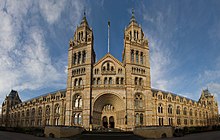Geoffrey Tandy
Geoffrey A. Tandy (* 1900 in Chaddesley Corbett , Worcestershire , † 1969 ) was a British algologist at the Natural History Museum in London . He was also known for his intelligence work at Bletchley Park during the Second World War . Here he was involved in deciphering messages from the Wehrmacht .
Career
Scientific training and activity
Tandy first attended the Grammar School in Kidderminster , later the Cathedral School in Salisbury . In 1918 he joined the Royal Field Artillery and reached the rank of Second Lieutenant . After a military scholarship, he earned a bachelor's degree from the University of Oxford in 1921 . Between 1922 and 1926 he was a research student and lecturer at the Birbeck Collage , which is part of the University of London . From 1926 he worked as a research assistant in the botanical department at the Natural History Museum in London. The main focus of his work was seaweed and monocotyledons . Between 1928 and 1929 he was involved in an expedition to the Great Barrier Reef . In 1931 and 1932 he was a visiting researcher on the Dry Tortugas for the Carnegie Institution of Washington .
Intelligence activity
In 1939, Tandy joined the Royal Naval Volunteer Reserve and was deployed at Bletchley Park, where specialists from a wide variety of fields worked during the Second World War to decipher encrypted Wehrmacht messages. He was responsible for captured documents, later he headed the technical news department. According to some sources, Tandy is said to have been used here because he was considered an expert in the field of cryptogams . Cryptogams are lower plants, including algae. Employees of the British secret service would have swapped this technical term with the term cryptogram , which means mathematical puzzles or ciphertexts. Tandy is said to have stayed at Bletchley Park, because the error was only noticed when he had already gained insight into the decryption project, which is classified as top secret. Tandy was finally able to apply his expertise when it was necessary to make captured but soaked code books legible. Bletchley Park itself refers to a comment in the National Post . Accordingly, Tandy was not in Bletchley Park by chance, but one of the numerous specialists from the various departments.
Later career
In 1948 Tandy moved to the British Foreign Office . At the same time his employment at the Natural History Museum ended. In 1958 he retired.
Personal / friendship with TS Eliot
Tandy's parents owned a pub in Chaddesley Corbett. In her first marriage, Tandy was married to Doris May Ellis, called Polly, who brought children into the marriage. His second marriage was Maire, with whom he had five children, including Genista McIntosh, Baroness McIntosh of Hudnall . Geoffrey Tandy was a close friend of the later Nobel Prize winner TS Eliot . He was also the godfather of a daughter of the Tandys. In 1937, two years before it was published, Geoffrey Tandy read poems from Old Possum's Book of Practical Cats on BBC radio . Numerous letters from Eliot to the Tandy family are kept in the British Library .
Web links
- Entry for Geoffrey A. Tandy and listing by and about Tandy on the Natural History Museum website.
- Entry to Geoffrey A. Tandy on the side of Bletchley Park.
- Entry on Tandy in the Biologorum index: Inverstigatores · Laboratoria Periodica
- CV of Tandy by David J. Collard
Individual evidence
- ↑ Article on Tandy's activity in Bletchley Park on War History online
- ↑ Operation Enigma - the silent struggle of the code breakers on the side of GEO
- ↑ Article on Tandy's activity in Bletchley Park on the Mirror page
- ↑ Article on Tandy's activity in Bletchley Park on the National Post
- ^ Letters from TS Eliot to the Tandy family, with drafts of his cat poems on the British Library page
- ^ 2 More TS Eliot Poems Found Amid Hundreds of His Letters on the New York Times page
| personal data | |
|---|---|
| SURNAME | Tandy, Geoffrey |
| ALTERNATIVE NAMES | Tandy, Geoffrey A. |
| BRIEF DESCRIPTION | British algologist and intelligence officer |
| DATE OF BIRTH | 1900 |
| DATE OF DEATH | 1969 |

